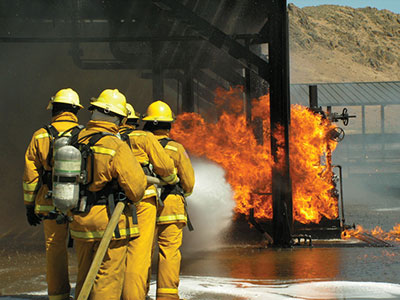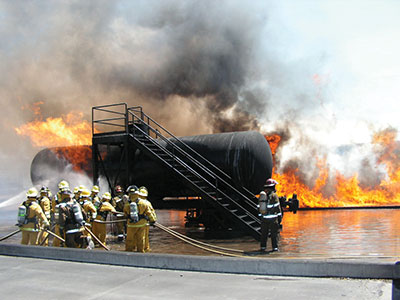
Features
Training
Trainer’s Corner: September 2013
As I was doing the final preparations for my course at FDIC Atlantic in June, I realized there was some important information that I had not addressed in my column on liquefied petroleum gas (LPG) in February, in particular, the incident that occurred on Oct. 2, 1997
September 9, 2013
By Ed Brouwer
As I was doing the final preparations for my course at FDIC Atlantic in June, I realized there was some important information that I had not addressed in my column on liquefied petroleum gas (LPG) in February, in particular, the incident that occurred on Oct. 2, 1997, during which two Carthage, Ill., volunteer firefighters were killed by a boiling liquid expanding vapour explosion (BLEVE).
 |
|
| The more time that the liquefied petroleum gas tank is exposed to fire conditions, especially fire impingement on the metal shell, the greater the risk of a boiling liquid expanding vapour explosion, or BLEVE.
|
As you read this background information, ask yourself if you would have done anything differently. (For the full report on this incident, visit www.usfa.fema.gov/downloads/pdf/publications/tr-120.pdf .)
The fire: According to the report by the U.S. Fire Administration, the incident occurred on a large farm about 16 kilometres north of the City of Carthage. The farm had two water ponds available for drafting, but no public water system. The closest hydrant was located about 1.2 kilometres away in the town of Burnside and was supplied by a four-inch
water main.
The initial fire involved the farm’s grain drying operation, which included two 3,785-litre LP gas fuel tanks. These tanks were located about 4.5 metres from the dryer and were less than 1.5 metres apart. The fire was observed to burn violently at times as the pressure relief valve began to operate intermittently, producing a loud noise and flames 12 to 15 metres high.
The call out: At about 4:39 p.m., 911 dispatch received a call for a dryer fire in the town of Burnside. The Carthage Fire Department was dispatched shortly after. The initial response was the department’s routine rural response assignment to what was thought to be a clothing dryer inside a house. (When will we learn that there are no routine fires?)
The response: At 4:48 p.m., Engine 11 and Rescue 10 arrived on the scene of the reported residential dryer fire, only to find it to be a grain dryer fire involving not one, but two large LP gas fuel tanks with nine- to 12-metre intermittent fire plumes coming from the safety relief valves – as well as a fully involved farm tractor.
During his walk-around, the fire chief learned that there were no life-safety issues and nothing of great value at risk; yet, he decided to set up a direct attack. Concerned that the west tank was angled towards their position, the fire chief decided to move the apparatus. Returning to the engine, he found firefighters had already pulled out a pre-connected hose line toward the fires. He ordered Engine 11 to relocate to the south side of the east grain silo. However, in the new position, the rear of the engine was not completely behind the silo and the tailboard was almost in line with the horizontal edge of the tank. It was while three firefighters were advancing pre-connected hose lines at the rear of Engine 11 that the BLEVE occurred.
Several pieces of the tank were blown harmlessly away, between 182 metres and 198 metres. However, the balance of the tank rocketed through the pole shed, striking the three firefighters at the rear of Engine 11. The first victim was standing at the tailboard and was knocked 15 to 23 metres away. The second victim, standing to the left of the first, was knocked about 40 metres away. Both died instantly. The third firefighter was airlifted from the scene. The tank came to rest nearly 304 metres away.
Your members should understand:
- The more time that the LP gas tank is exposed to fire conditions, especially fire impingement on the metal shell, the greater the risk of BLEVE. In this case, the fire had been heating the tanks for more than 10 minutes with a great chance of flame impingement on the top of the tanks.
- Long fire exposure times and operating pressure relief valves should indicate that the potential for tank failure is imminent. The fire chief in Illinois believed that the relief valve vented two or three times during his size-up.
- Farms and construction sites are typical locations of portable and temporary equipment installations. Expect the unexpected.
- These types of incidents are unpredictable.
- Aggressive actions to cool the tank should be tempered with caution when the area around the tank can be quickly evacuated.
- Should you see steam coming off of the tank surface – get out fast!
Please drive home the fact that containers can be in serious danger of experiencing a BLEVE after less than 10 minutes of intense flame impingement. This time includes the time it takes for you to arrive on scene, do a size-up and place your apparatus and sufficient hose streams in operation.
 |
|
| There really is no safe time period in which operations can be established for a liquefied petroleum gas tank fire. In many cases, the best course of action is to retreat to a safe location and monitor the situation from a distance.
|
In other words, there really is no safe time period in which operations can be established. In many cases, the best course of action is to retreat to a safe location and monitor the situation from a distance. The firefighters in this incident had six minutes.
The Latin phrase, Amat Victoria Curam, is painted on our fire truck driver’s truck’s door. The translation Victory Loves Preparation is on the passenger door. The following steps can help you to be prepared.
Pre-plan sites in your area. Time your response to whatever possible BLEVE sites you have. Preplan your strategies.
Know the size and location of tanks in your area, your water supply, the duration of water supply, the capacities of relay units, the water volume of monitors, the capacities of pumps, available personnel and backup.
Plan safe observation points for each potential BLEVE. Develop evacuation plans and know how to contact experts in liquefied gases (for more information, contact the Canadian Transport Emergency Centre, operated by the Transportation of Dangerous Goods Directorate of Transport Canada (CANUTEC) at 613-996-6666).
First-in fire officers must be well trained in hazard and risk analysis. More often than not, it is better to evacuate the area in anticipation of a tank failure, rather than placing firefighters at risk trying to prevent the failure.
The following two experiments were done during our FDIC session:
With a small propane torch I heated up a standard light bulb, which I held with Channellock pliers. I held the flame on the glass area for a count to 35. Then I dipped the bulb in a bowl of cold water – the bulb shattered due to thermal shock.
I also took an empty pop can and filled it about one-quarter full of water. I held the can with the pliers and moved the propane flame along the can at the water level. There was no discoloration or weakening of the can. When the water started to boil, steam could be seen coming out of the opening. I then moved the flame to the top of the can where there was no liquid. Immediately it discolored and weakened the metal; after a second or two the metal was so weak it broke apart as I tapped it with the torch tip.
Until next time, stay safe and remember to train like lives depend on it, because they do.
In memory of W. Douglas Buckert, 23, and Michael D. Mapes, 35, Carthage Volunteer Fire Department. May we honour our fallen brothers by learning from their sacrifice.
Ed Brouwer is the chief instructor for Canwest Fire in Osoyoos, B.C., and Greenwood Fire and Rescue. The 21-year veteran of the fire service is also a fire warden with the B.C. Ministry of Forests, a Wildland Urban Interface fire suppression instructor/evaluator and a fire-service chaplain. Contact Ed at ebrouwer@canwestfire.org
Print this page